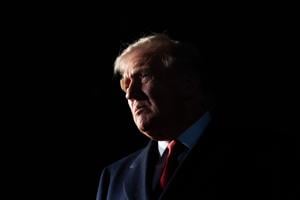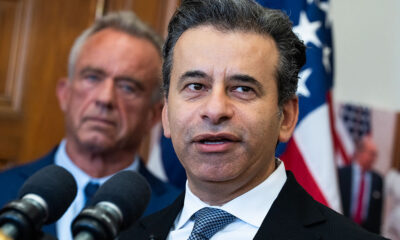World
Trump Witnesses Ceasefire Agreement Between Thailand and Cambodia

U.S. President Donald Trump attended a significant ceasefire ceremony in Kuala Lumpur, Malaysia, on March 3, 2024. This event marked the signing of an expanded ceasefire agreement between Thailand and Cambodia, aimed at halting ongoing skirmishes along their disputed border. Trump’s involvement is seen as a catalyst for these negotiations, following his earlier threats to impose economic pressure if the conflicts did not cease.
The agreement stipulates that Thailand will release Cambodian prisoners while Cambodia will begin withdrawing heavy artillery as part of a phased approach to peace. Regional observers will monitor the situation to prevent any resurgence of hostilities. During the ceremony, Trump remarked, “We did something that a lot of people said couldn’t be done.” Both Cambodian Prime Minister Hun Manet and Thai Prime Minister Anutin Charnvirakul hailed the agreement, with Anutin stating it provides “the building blocks for a lasting peace.”
This ceremony was Trump’s first official engagement after arriving at the annual summit of the Association of Southeast Asian Nations (ASEAN). His visit to the region is strategically timed as he seeks to enhance his reputation as a global dealmaker amidst ongoing domestic challenges, including a government shutdown and trade disputes.
Upon landing in Malaysia shortly before 0200 GMT, Trump showcased his characteristic flair, participating in local cultural performances while holding both an American and a Malaysian flag. Later in the day, he is expected to sign trade agreements with Malaysia, particularly concerning critical minerals, as the U.S. aims to diversify its supply chains away from China, which has recently restricted key exports vital for technology manufacturing.
Regional Tensions and Economic Strategies
The recent ceasefire comes after intense fighting between Thailand and Cambodia in July 2023, which resulted in dozens of casualties and the displacement of hundreds of thousands of individuals. The two nations have long-standing territorial disputes, and violence has frequently erupted along their border. Trump’s economic leverage was pivotal; he threatened to withhold trade agreements unless the fighting ceased, which many believe prompted both countries to engage in negotiations.
Political analysts view the ceasefire as a significant achievement for Trump, particularly as it positions him as an international peacemaker. Ou Virak, president of the Future Forum think tank in Phnom Penh, noted, “The fact that Trump was holding the tariff card was actually very significant. That’s probably the main reason… the two sides agreed immediately to the ceasefire.” This event serves not only as a diplomatic breakthrough but also as a platform for Trump to present himself as a leader committed to resolving conflicts—a narrative he has actively promoted in his pursuit of a Nobel Peace Prize.
Malaysian Prime Minister Anwar Ibrahim commended the agreement during the summit, emphasizing that “reconciliation is not concession, but an act of courage.” The Thai Foreign Ministry spokesperson characterized the deal as a “joint declaration,” affirming both nations’ commitment to improving bilateral relations. He cautioned, however, that while the agreement is a positive step, “work has just begun.”
Trade Talks and Future Engagements
As Trump navigates his diplomatic engagements in Southeast Asia, trade discussions remain a central focus. He is scheduled to meet with Brazilian President Luiz Inácio Lula da Silva, but will not engage with Canadian Prime Minister Mark Carney due to tensions stemming from a Canadian advertisement protesting U.S. tariffs. Trump recently announced plans to increase tariffs on Canada, reflecting ongoing trade disputes.
On the global trade front, Trump expressed optimism about his upcoming meeting with Chinese leader Xi Jinping, expected to occur in South Korea. He outlined key priorities for the discussions, including fentanyl trafficking and soybean sales, stating, “I think we have a really good chance of making a very comprehensive deal.”
While details about the agreements Trump plans to finalize remain limited, he has indicated confidence in securing beneficial terms with both Japan and South Korea. As he continues to assert America’s position in international trade, the outcomes of these discussions are anticipated with interest.
Notably absent from the summit is Indian Prime Minister Narendra Modi, whose relationship with Trump has soured somewhat in recent months. Tensions have risen following Trump’s comments regarding a recent conflict between India and Pakistan, alongside his decision to raise tariffs on Indian oil imports from Russia.
As the summit progresses, the focus remains on whether Trump’s diplomatic efforts will yield sustainable solutions to regional conflicts and trade challenges.
-

 Science1 week ago
Science1 week agoResearchers Challenge 200-Year-Old Physics Principle with Atomic Engines
-

 Politics1 week ago
Politics1 week agoNHP Foundation Secures Land for 158 Affordable Apartments in Denver
-

 Health1 week ago
Health1 week agoNeuroscientist Advocates for Flag Football Until Age 14
-

 Lifestyle1 week ago
Lifestyle1 week agoLongtime Friends Face Heartbreak After Loss and Isolation
-

 World1 week ago
World1 week agoGlobal Military Spending: Air Forces Ranked by Budget and Capability
-

 Health1 week ago
Health1 week agoFDA Launches Fast-Track Review for Nine Innovative Therapies
-

 Top Stories2 weeks ago
Top Stories2 weeks agoUnforgettable Moments: The Best Victoria’s Secret Performances
-

 Business1 week ago
Business1 week agoSpirit Airlines Cuts Workforce with Furloughs for 365 Pilots
-

 Politics1 week ago
Politics1 week agoIsraeli Air Strikes in Lebanon Kill One, Wound Seven Amid Tensions
-

 World1 week ago
World1 week agoTroops to Enjoy Buffalo Chicken, Thai Curry in 2026 MREs
-

 Business1 week ago
Business1 week agoMaine Housing Inventory Surges to Post-Pandemic High
-

 Sports1 week ago
Sports1 week agoCommanders Face Off Against Cowboys with Key Injuries Looming









